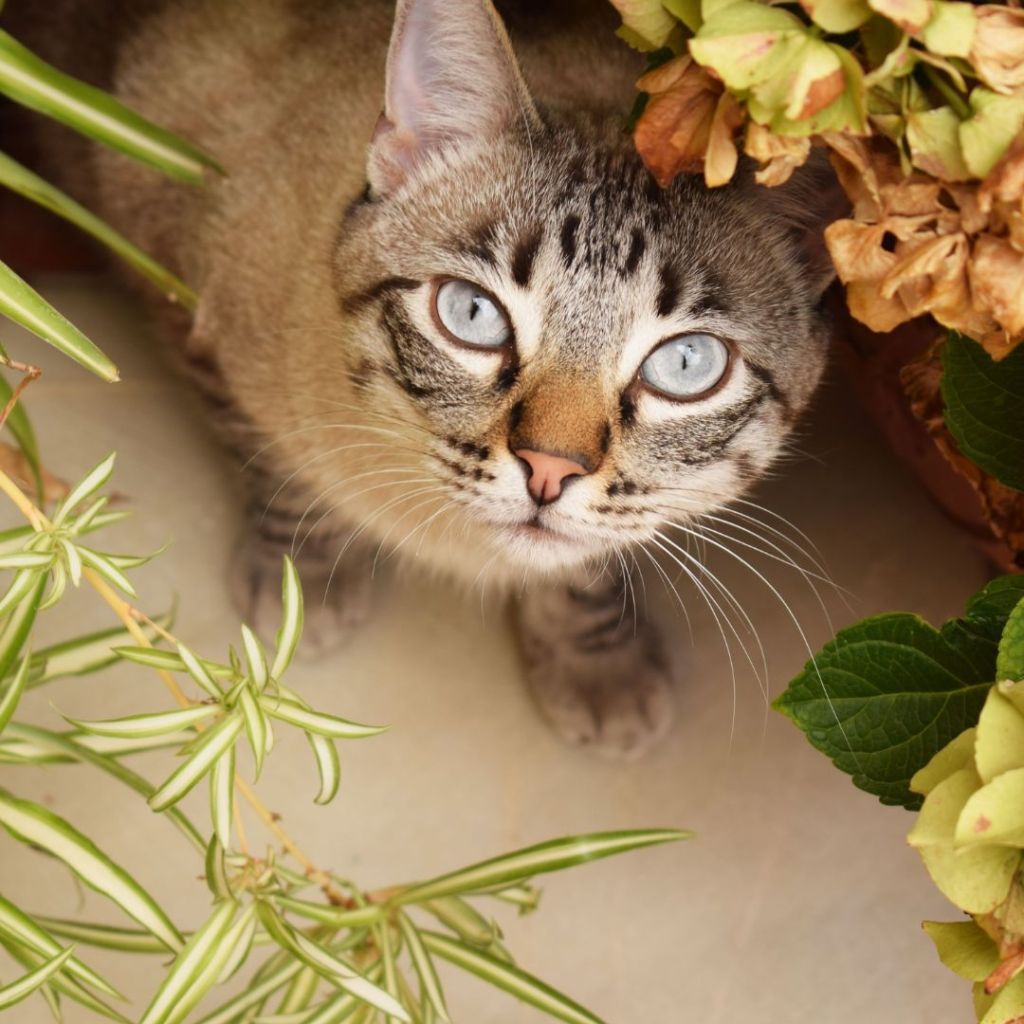
Who Let the Cats Out? Steps to Letting Your Cat Outside for the First Time
21 Apr 2023.
If you have a patio or garden it’s possible your cat will want to go outside and explore. Felines are curious by nature, and most will enjoy spending time outdoors. However, letting a cat out for the first time can be nerve-racking for any fur parent and you want to make sure you approach it safely. Read on for Cat in a Flat’s helpful steps and tips to letting your cat outside for the first time.
Table of contents
How soon can I let my cat go outside?
When you should let your cat go outside will depend on their age as well as how comfortable they are inside their home. Here are the suggested time frames, depending on if your feline is an adult or a kitten.
Adult cats
You may have heard the saying “you can’t teach and old dog new tricks” but there’s no such thing for cats. Considering felines pretty much domesticated themselves and they’re also much more independent than dogs, you can’t necessarily ‘teach’ your cat to go outside. Rather, your feline will decide for themselves if that’s what they want to do.
Personality and breed will have an impact on whether your cat wants to go outside. Some breeds, such as Bengals or Maine Coons, are more curious and active and may adjust very quickly to time outdoors. Others, such as Ragdolls, may prefer limited outdoor time or to want to stay entirely inside. Again, you can’t determine this solely on breed, as personalities vary wildly within the same breed or types of cats.
If you’ve adopted an adult kitty or just moved house with your cat and now have a wonderful patio or garden for Mr Whiskers to play in, don’t let them go outside right away. It’s best to wait between three to six weeks to give your cat time to settle into their new home first. It’s tempting to let Mr Whiskers out right away, but a new environment—inside and out—can be overwhelming for your fur friend.

Kittens
The timescale for when you can let a kitten go outside is slightly different than for adult cats. The benefit with kittens is that they’re able to learn and adjust more quickly to a new environment. It’s also unlikely that they’ll have negative past experiences that will make them scared of the outdoors or particularly timid or shy.
However, just because your fur friend is a kitten doesn’t mean they’ll automatically adjust to being outdoors. Make sure to read up on how to look after a young kitten, and only let your little furry friend go outdoors after they’ve been spayed or neutered, had all their vaccinations, and spent several weeks adjusting to their new home. Aim for around when your kitten is four to five months old. Even then, only allow your kitten to spend time outdoors under your supervision.
Steps to letting your cat go outside
Train your cat
It’s a common misconception that it’s impossible to teach cats tricks. However, with the right approach, you can actually train your kitty to obey basic commands. This way you can get them back inside if they wander too far or find themselves in a dangerous situation. Here are a few tips for training your cat:
- Dab your hands with a scent your cat will enjoy. A spritz of catnip spray should do the job!
- Combine treats with a clicker. For example, call your cat’s name. If they immediately come, give them a treat while using the clicker. Over time, you can withdraw the treats and only use the clicker, as your cat will associate it with a reward.
- Reinforce verbal commands. Only once your cat has learned to respond to the verbal command should you stop giving them treats. However, continue to use the clicker every time your cat obeys.
- Keep your training sessions short so Mr Whiskers doesn’t get bored. Try the trick out just a few times every day so you don’t frustrate your cat.
- At the end of each session, reinforce the positive experience by praising, cuddling, and playing with your cat.

Things to do BEFORE letting your cat outside
Once you’ve trained Mr Whiskers to come when called and to obey basic commands, you are ready to let your cat go outside! However, here is a checklist of things you should do beforehand:
- Microchip your cat. It’s important that your feline can be identified should they ever wander off or get injured. The most effective way of identifying lost kitties is with a microchip. If someone comes across your injured or lost cat, they can have their microchip scanned at a vet’s office or shelter and the chip will link to your details. Check to make sure your fur friend’s microchip details are up to date so you can be easily contacted!
- Put an ID tag on your cat. Even if your kitty is microchipped it never hurts to have a secondary form of identification. Before you let your cat go outside, get them used to wearing a quick release safety collar with an ID tag. However, if Mr Whiskers doesn’t tolerate wearing a collar, don’t force them to.
- Cat-proof your outdoor space. Place netting around the edges of your outdoor space to discourage your cat from jumping up onto walls. This is especially important if you live on a high floor, as you don’t want your furry friend to accidently fall. Make your outdoor area appealing to your kitty by planting catnip or cat mint (in pots or in the ground) and place cushions or a cat tree outside so your feline can comfortably lounge or nap.
What to do the first time you let your cat out
- Accompany your kitty the first few times they’re outdoors. When you go outside, leave the door to the house open so that your feline can quickly get back in if they feel nervous or scared. NEVER carry your cat outside as this will make them anxious and give them a negative association of the outdoors. Let your kitty choose to go out in their own time.
- Take a food or toy out with you as a reward. Sit down quietly and allow your cat to explore freely. If they go too far, call them back and reward them with a treat when they come. However, don’t take them back inside right away. Reward them and let them continue to explore. This way they won’t associate coming to you with going back inside—especially if they really enjoy being outdoors!
- Build up the length of time your cat is outdoors over a few sessions. Start with ten minutes, then gradually increase the time if your kitty seems comfortable.
- Once your cat is relaxed being outdoors, let them come and go unaccompanied. You may consider installing a cat door so your kitty can come and go freely and doesn’t need to rely on you to let them in and out.
What to watch out for when letting your cat outside
- Keep an eye on the weather. Avoid letting your cat out during inclement weather. Cats can overheat in very hot weather, and freezing temperatures can be dangerous for them as well. The same goes for heavy rain, high winds and other types of extreme weather.
- Pick the right time of day. There are a lot more hazards outdoors for your cat than indoors, and these increase in the evening, at night, and in the early morning. Getting hit by a car is one of the most common dangers cats face out of doors, and this is much more likely to happen at night when visibility is low. So, while it may be tempting to allow Mr Whiskers unlimited access to the cat door, try to limit your cat’s time outdoors to the daylight hours.
- Be vigilant about your feline’s health. Always ensure that your cat is up to date on vaccinations before letting them go outside. Also be aware of the symptoms of a sick or injured cat and monitor your kitty’s health and behaviour before and after they go outside.
Can my cat sitter let my cat outside?
If you’re going out of town and you book a cat sitter, discuss with them beforehand whether your kitty should be allowed out while you’re away. If your cat enjoys daily patio time, make sure your sitter feels comfortable letting them out into the enclosed space and calling them back inside. However, if they’re not okay doing so, don’t press the issue. You don’t want your cat sitter (and by extension your feline) to feel stressed while caring for your kitty.
If you have a garden, it’s recommended you ask your cat sitter to keep Mr Whiskers indoors, as it’s much easier for a feline to escape from a yard or garden. It’s possible your fur friend may be upset that you’re gone they could try to run away or refuse to come when the cat sitter calls. Avoid potential stress by simply asking your cat sitter to keep your kitty inside while you’re away on your trip.
Cats are independent creatures so it’s important to respect your feline’s person preferences. If your kitty isn’t interested in going outside, don’t force them. And remember, outdoor time is not a substitute for quality playtime and indoor stimulation. Make sure you still spend time playing with your cat every day and make your indoor space as cat-friendly as possible.
- #catinaflat
- #pet care
- Cat Care
- let your cat outside


